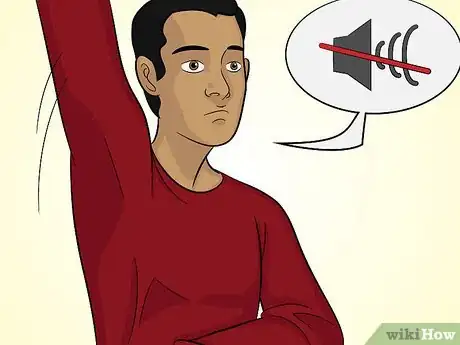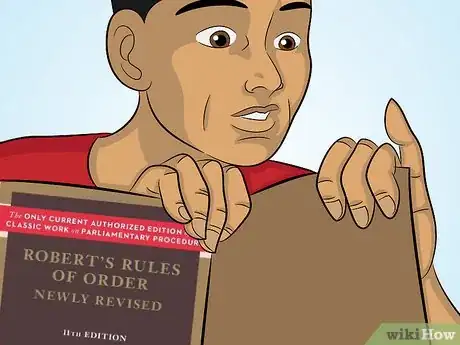This article was co-authored by wikiHow Staff. Our trained team of editors and researchers validate articles for accuracy and comprehensiveness. wikiHow's Content Management Team carefully monitors the work from our editorial staff to ensure that each article is backed by trusted research and meets our high quality standards.
This article has been viewed 24,151 times.
Learn more...
Robert's Rules of Order were first written in 1876 by a military engineer who intended to create a standardized set of rules for conducting meetings. These rules allow groups of people to efficiently debate subjects in a way that provides equal and fair orders for all members. The Rules originate in parliamentary procedure, and are designed in such a way that they are adaptable to any organization's needs.[1]
Steps
Presenting Motions and Debating
-
1Gain the floor. Before a member speaks, he must be acknowledged by the chairperson. Depending upon your organization's procedure, he should either raise his hand or standing and state “Mr./Madam Chairperson.” The member is not allowed to continue speaking until the chairperson has acknowledged him by name.
- It is against procedure to begin speaking until the last speaker has finished his statement.[2]
-
2Bring a motion. To bring a motion to consideration by the group, a member must be acknowledged by the chairperson. At which point, the speaker can say “I move that we (motion).” For the motion to be discussed another speaker must rise and say “I second that we (motion).”
- The motion is some sort of substantive proposal that the organization is can enact. The debate should focus exclusively on whatever the current motion is.
- For example, “I move that we pass the budget as is.”
- Oftentimes, motions to be voted on will be set on a predetermined agenda. Robert's Rules of Order, however, allow this agenda to be amended, by either adding motions, taking motions off the agenda, changing the order of the motions, or amending the motions.[3]
Advertisement -
3Bring the motion to debate. Debate over the motion does not begin until the chairperson restates the motion and asks “are you ready for the question?” If no one stands to discuss the motion, then it goes straight to vote.[4]
-
4Give preference to the member proposing the motion. If debate over the motion ensues, the person who moved the motion has the first right to speak. Since it is his motion, he has the most direct knowledge of its intent and can explain it better than his peers.[5]
-
5Follow rules for a civil debate on the subject under discussion. The rules are meant to ensure that all debate centers on the merits of the particular motion under discussion. Discussion of anything else can be ruled out of order.
- All remarks should be directed at the chairperson. This is designed to prevent cross talk between the members that could escalate into a personal confrontation.[6]
- You are not permitted to discuss personalities or motives. You should refrain from alluding to people by name or using language that is not courteous.
- No member is permitted to speak twice until everyone else interested in speaking has spoken at least once.[7]
- Ideally, debate should alternate between speakers who are pro and con.
- Comments should be specifically directed at either a motion or the amendment, not both, so as to make the import of the comment clear.[8]
-
6Amend the motion. Anyone can ask to have the wording of the motion changed. To do this, he must be acknowledged by the chairperson. Then, they should stand and say “Madame Chair, I move that the motion be amended by adding the following words _________.” Another member must second, and then a majority vote can be held.
- Alternatively, one can ask that “Madame Chair, I move that the motion be amended by striking the following words _________.” One can even ask to both add and subtract words for the motion: “Madame Chairperson, I move that the motion be amended by adding the following words ____________, and by striking the following words _________.”[9]
- If the person who made the motion is friendly to the amendment, he can stand and ask to modify the motion, and no majority vote is required.[10] If the motion is changed, the person who originally seconded it is entitled to withdraw support. At that point, it will be necessary to find another person to second the motion.[11]
-
7Bring the motion to vote. After debate has slowed, the chairperson can stand and ask again “Are you ready for the question.” If no one stands to continue the debate, the chairperson will ask “As many as are in favor, say 'Aye.' Those opposed say 'nay.” After counting votes, the chair will announce the results.
- When the chair announces the results, she will either say “The 'ayes' have it, and (repeat the text of the motion)” or “The nays have it and the motion fails.”[12]
- Alternatively, a member can call the motion to vote. Once being acknowledged, announce “I move the previous question.” The chair will call a vote. A 2/3rds majority is required to end the debate. At that point, a separate vote will be held on the motion.[13]
Using Special Procedures
-
1Call point of personal privilege. This can be used to interrupt a speaker if the member is having difficulty participating in the debate, particularly because it is too loud to hear the speaker or the person is uncomfortable with the temperature. A member does not need to be acknowledged to call point of privilege.[14]
- Member should stand and announce “Point of Personal Privilege” After the chair asks the member to “State your point,” the member should indicate what his issue is.[15]
-
2Call point of order. A point of order can be called when it is believed that the speaker is violating a rule. This can be used, for example, if the speaker is talking about something other than the motion at hand or is attacking individuals. The person calling a point of order does not need to be acknowledged by the chair.
- The person calling point of order should stand and announce “I rise to a point of order.” After being acknowledged by the chair, he can explain his objection.[16]
-
3Point of information. This procedure allows someone, without acknowledgement of the chair, to stand and ask a question. The question should pertain to a fact relevant to the motion, like the amount of money in the budget.
- Speaker should stand and announce, “point of information.”[17]
-
4Refer to a committee. If you believe that a matter needs further consideration and research before voting on it, you can ask to refer it to the committee. The committee is a smaller group that analyzes the motion in greater detail. Afterward the motion, or an amended motion, can be brought to the whole group for approval.
- After being acknowledged, the speaker should announce “Madame Chair, I move that the question be referred to the committee made up of members ______, _______, _______, and _______.” If the committee has a formal name, you can also reference the name, like “finance committee.”[18]
Learning Robert's Rules of Order
-
1Obtain a copy of Robert's Rules of Order. Robert's Rules of Order are complex, and it can be difficult to memorize them all. Having a copy of the Rules available at meetings will allow an individual to look up any rules for which he needs clarification.[19]
- The full text of older editions of the Rules are available for download on the internet. The current edition of the Rules, as well as other editions are available for purchase in book format.
- The website for Robert's Rules of Order also contains some quick summaries of the rules and treatments of specialized subjects.[20]
-
2Have all members review the rules. While the chairperson of the meeting bears much of the responsibility of running the meeting, Robert's Rules of Order can only be effective if all members at the meeting are willing to follow the rules. Board meetings require multiple people to discuss ideas and proposals, and following the Rules allows for this discussion to flow in a courteous and respectful manner.
- Members will also be disadvantaged in the discussion if they do not fully comprehend the rules. That is because there are many specialized maneuvers that speakers can use to their advantage in debates. There are so many of this, it can be hard for a novice to exert as much control over the debate as an expert.[21]
- Circulate a summary of the basic rules to each member, and hold a meeting to discuss the rules and practice them. The Rules are fairly easy to understand, but putting them into practice while engaging in a thoughtful dialogue can take some work. It requires members to think about the Rules before speaking. The only way to get the Rules down is to practice them in a group setting.
-
3Elect an expert as chair. The chairperson will be responsible for moderating the debate and ensuring that rules are properly enforced. The chairperson might even be required to clarify and explain the rules to the members. It is, therefore, imperative that the chairperson be particularly knowledgeable of the rules.[22]
-
4Practice. The only way to master the rules is to practice. After running many meetings under these rules, you should develop a good sense for how they work. You might even be able to find courses offered locally that will allow you to learn and practice procedures.
References
- ↑ http://www.robertsrules.com/history.html
- ↑ http://www.robertsrules.org/
- ↑ http://diphi.web.unc.edu/files/2012/02/MSG-ROBERTS_RULES_CHEAT_SHEET.pdf
- ↑ http://www.robertsrules.org/
- ↑ http://www.robertsrules.org/
- ↑ http://www.robertsrules.org/
- ↑ http://www.robertsrules.org/
- ↑ http://www.roberts-rules.com/debateprotocol.htm
- ↑ http://diphi.web.unc.edu/files/2012/02/MSG-ROBERTS_RULES_CHEAT_SHEET.pdf
- ↑ http://www.robertsrules.org/
- ↑ http://www.robertsrules.org/
- ↑ http://diphi.web.unc.edu/files/2012/02/MSG-ROBERTS_RULES_CHEAT_SHEET.pdf
- ↑ http://diphi.web.unc.edu/files/2012/02/MSG-ROBERTS_RULES_CHEAT_SHEET.pdf
- ↑ http://www.robertsrules.org/
- ↑ http://diphi.web.unc.edu/files/2012/02/MSG-ROBERTS_RULES_CHEAT_SHEET.pdf
- ↑ http://diphi.web.unc.edu/files/2012/02/MSG-ROBERTS_RULES_CHEAT_SHEET.pdf
- ↑ http://diphi.web.unc.edu/files/2012/02/MSG-ROBERTS_RULES_CHEAT_SHEET.pdf
- ↑ http://diphi.web.unc.edu/files/2012/02/MSG-ROBERTS_RULES_CHEAT_SHEET.pdf
- ↑ http://www.rulesonline.com/rror_01.htm
- ↑ http://www.roberts-rules.com/
- ↑ http://www.robertsrules.org/
- ↑ http://diphi.web.unc.edu/files/2012/02/MSG-ROBERTS_RULES_CHEAT_SHEET.pdf


















-Step-23.webp)




















-Step-23.webp)


































